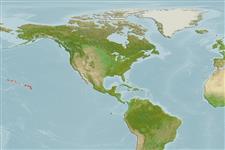Common names from other countries
Classification / Names / Names
Namen | Synonyme | Catalog of Fishes (gen., sp.) | ITIS | CoL | WoRMS
Environment: milieu / climate zone / depth range / distribution range
Ökologie
Riff-verbunden; tiefenbereich 0 - 21 m (Ref. 2902). Tropical
Indo-Pacific: Oman, Philippines and Hawaii.
Length at first maturity / Size / Gewicht / Alter
Maturity: Lm ? range ? - ? cm
Maximum depth from Ref. 101475. Found among rocks and rubble (Ref. 105268). Inshore detritus and deposit feeder (Ref. 98471). Associated with the commensal portunid crab Lissocarcinus orbicularis and parasitic eulimid snail M. nitidula (Ref. 105266). Associated with coral communities. Dwells on sediments between coral heads (Ref. 129602).
Life cycle and mating behavior
Geschlechtsreife | Fortpflanzung | Ablaichen | Eier | Fecundity | Larven
Members of the class Holothuroidea are gonochoric and have only one gonad. Spawning and fertilization are both external and some exhibit brooding. Life cycle: Embryos develop into planktotrophic larvae (auricularia) then into doliolaria (barrel-shaped stage) which later metamorphose into juvenile sea cucumbers.
Samyn, Y., D. Vandenspiegel and C. Massin. 2006. (Ref. 2900)
IUCN Rote Liste Status (Ref. 130435)
CITES Status (Ref. 108899)
Not Evaluated
Not Evaluated
Bedrohung für Menschen
Harmless
Nutzung durch Menschen
Fischereien: kommerziell
| FishSource | Sea Around Us
Tools
Mehr Information
Alter/Größe
Wachstum
Länge-Gewicht
Länge-Länge
Morphologie
Larven
Dichte
Internet Quellen
Estimates based on models
Preferred temperature
(Ref.
115969): 24.4 - 28.4, mean 25.3 (based on 49 cells).
Preiskategorie
Unknown.
